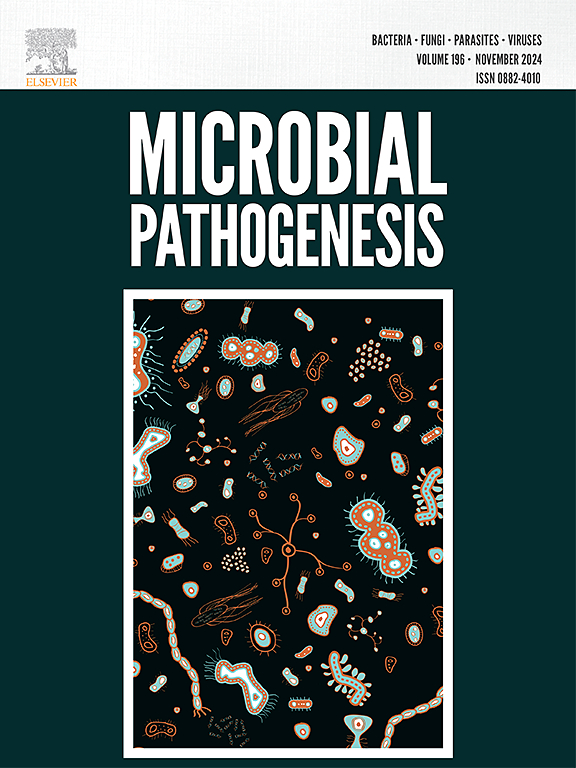碘化 Fmoc-苯丙氨酸对金黄色葡萄球菌的抗生物膜和抗病毒潜力
IF 3.3
3区 医学
Q3 IMMUNOLOGY
引用次数: 0
摘要
金黄色葡萄球菌能够形成生物膜并产生毒力因子,对公共卫生构成重大风险,导致抗生素耐药性和治疗并发症的增加。这强调了对新型抗菌剂控制的迫切需要。基于卤化能提高抗菌效果这一前提,本研究调查了卤代苯丙氨酸有效抑制金黄色葡萄球菌生物膜形成和毒力活性的能力。在 29 种卤代化合物中,Fmoc-4-碘苯丙氨酸(Fmoc-Iodo-Phe)对金黄色葡萄球菌的抗生物膜效果最高,在 50 μg/mL 的浓度下可减少 94.3%。显微镜研究证实了它预防和破坏成熟生物膜的能力。在 10 μg/mL 的浓度下,Fmoc-Iodo-Phe 能明显抑制毒力因子,如细胞表面疏水性、溶血素和粘液的产生。它的耐药性发展倾向较低,能有效抑制耐甲氧西林金黄色葡萄球菌(MRSA)和表皮葡萄球菌形成的生物膜,但对革兰氏阴性菌无效。基因表达分析和分子对接表明,由于 Fmoc-Iodo-Phe 与 AgrA DNA 结合位点上的关键残基有很强的相互作用,它可以靶向 AgrA 法定量感应级联。值得注意的是,Fmoc-Iodo-Phe 在秀丽隐杆线虫模型中无细胞毒性,并且符合基于 ADMET 预测的药物可药性标准。因此,我们的研究结果表明 Fmoc-Iodo-Phe 是一种很有前景的抗金黄色葡萄球菌感染的候选抗菌药物,它具有替代传统抗生素的潜力。本文章由计算机程序翻译,如有差异,请以英文原文为准。
Antibiofilm and antivirulence potentials of iodinated fmoc-phenylalanine against Staphylococcus aureus
Staphylococcus aureus poses significant risks to public health due to its ability to form biofilm and produce virulence factors, contributing to the increase in antibiotic resistance and treatment complications. This emphasizes the urgent need for novel antimicrobial controls. Based on the premise that halogenation improves antimicrobial efficacy, this study investigated the ability of halogenated phenylalanine to effectively inhibit S. aureus biofilm formation and virulence activities. Among 29 halogenated compounds, Fmoc-4-iodo-phenylalanine (Fmoc-Iodo-Phe) displayed the highest antibiofilm effect against S. aureus, achieving 94.3 % reduction at 50 μg/mL. Microscopic studies confirmed its ability to prevent and disrupt mature biofilms. At 10 μg/mL, Fmoc-Iodo-Phe markedly inhibited virulence factors, such as cell surface hydrophobicity, hemolysin and slime production. It showed low propensity for resistance development and effectively inhibited biofilms formed by methicillin-resistant S. aureus (MRSA) and S. epidermidis, but was inactive against Gram-negative bacteria. Gene expression analysis complemented by molecular docking suggest that Fmoc-Iodo-Phe could target the AgrA quorum sensing cascade due to strong interactions with key residues at its DNA binding sites. Notably, it was non-cytotoxic in Caenorhabditis elegans model and satisfied drug-likeliness criteria based on ADMET prediction. Therefore, our findings position Fmoc-Iodo-Phe as a promising antimicrobial candidate against S. aureus infections, underscoring its potential as an alternative to traditional antibiotics.
求助全文
通过发布文献求助,成功后即可免费获取论文全文。
去求助
来源期刊

Microbial pathogenesis
医学-免疫学
CiteScore
7.40
自引率
2.60%
发文量
472
审稿时长
56 days
期刊介绍:
Microbial Pathogenesis publishes original contributions and reviews about the molecular and cellular mechanisms of infectious diseases. It covers microbiology, host-pathogen interaction and immunology related to infectious agents, including bacteria, fungi, viruses and protozoa. It also accepts papers in the field of clinical microbiology, with the exception of case reports.
Research Areas Include:
-Pathogenesis
-Virulence factors
-Host susceptibility or resistance
-Immune mechanisms
-Identification, cloning and sequencing of relevant genes
-Genetic studies
-Viruses, prokaryotic organisms and protozoa
-Microbiota
-Systems biology related to infectious diseases
-Targets for vaccine design (pre-clinical studies)
 求助内容:
求助内容: 应助结果提醒方式:
应助结果提醒方式:


